By Emily Rees Koerner
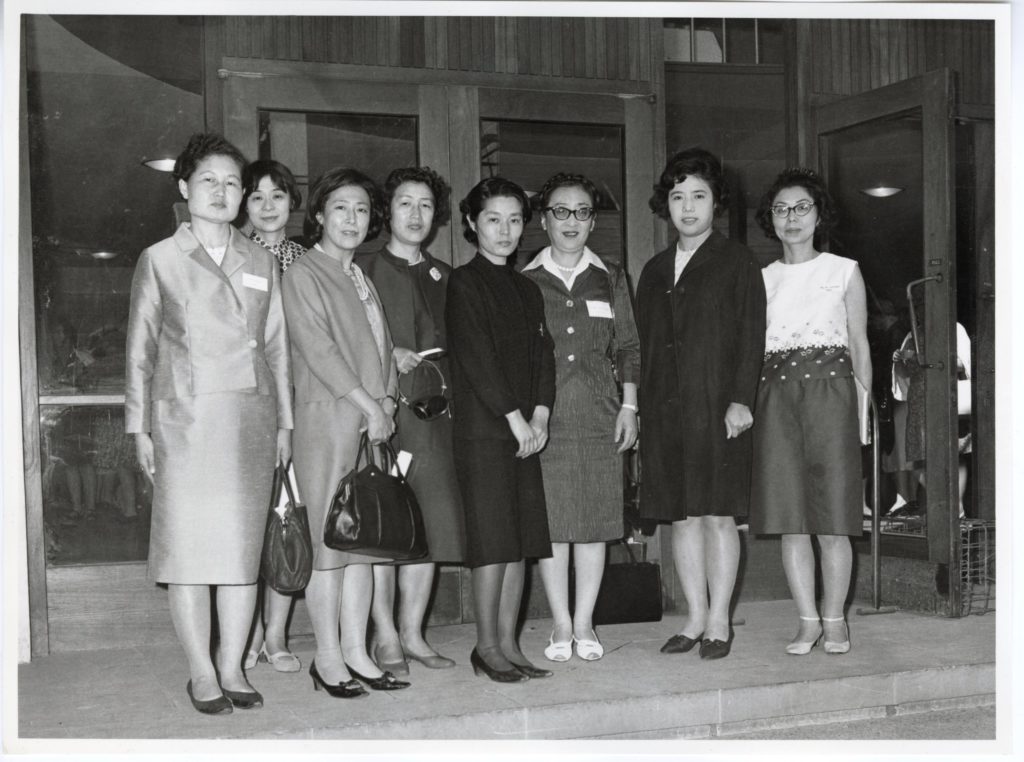
In 1964 nearly 500 women with backgrounds in science and engineering, from around 35 countries across the world, came together in New York, USA. These women were the first attendees of the International Conference of Women Engineers and Scientists (ICWES), a global conference that exists to this day to discuss contemporary issues in the fields of science and engineering and the promotion of women’s place within them.
The first meeting marked the beginning of a formalised transnational approach to bringing women in STEM from across the world together. Now managed by the International Network of Women Engineers and Scientists (INWES), the conference has taken place 17 times every three-four years in countries across Asia, Africa, North America, Australia and Europe. Information on some of these is available online, for example ICWES 11 held in Tokyo (1999), ICWES 15 in Adelaide (2011), and ICWES 17 in New Delhi (2017).
However, as with so many aspects relating to the history of women’s participation in STEM, this global event has not received as much attention as its significance warrants. To highlight the importance of INWES, this blogpost will focus on the first two conferences that took place in New York in 1964 (chiefly organised by the United States’ Society for Women Engineers (SWE)) and in 1967 in Cambridge, England (chiefly organised by the United Kingdom’s Women’s Engineering Society (WES)).
Archival material kindly supplied by the SWE archives held at Wayne State University, Detroit and the archives held at the Institution of Engineering and Technology (IET), London, reveals important information about the hundreds of women who came together at these conferences. By locating these women in their working lives we can learn about the international history of women’s participation in STEM fields in the mid-20th century.
A list of registered attendees for the first two ICWES conferences can be found in the published proceedings with additional information such as their nationality, company, field, and affiliation to organisations, for example, SWE or WES. Usefully the 1964 proceedings have been digitised by SWE and are available here.
We have entered this information into a spreadsheet, organised by fields, so that the data can be more easily analysed, including assessing number of attendees per country and continent, the women who attended both 1964 and 1967 meetings, and where available, the different fields and professions the attendees worked in.
For both the first two ICWES meetings the majority of attendees come from the host countries. At the 1964 conference in the USA, there are 93 entries from non-USA attendees (out of 493 listed), while at the second in 1967 in the UK, there are 184 non-UK attendees, of which 97 are from the USA (out of 309 listed). We think that the larger number of international attendees at the second meeting might have something to do with WES’s historical global outlook.
Several names on the early ICWES attendees list will be familiar. Examples from the USA include industrial engineer Lillian Gilbreth, chemical and electrical engineer Beatrice Hicks, computer scientist Grace Hopper, and aviator Katharine Stinson; and from the UK, electrical engineer and photometrist Isabel Hardwich, electrical engineer Marjorie Bell, electrical and aeronautical engineer Winifred Hackett, and radar engineer Elizabeth Laverick.
To understand the global nature of the ICWES conference, we should note that – perhaps for the first time – women from all parts of the world came together to celebrate their roles in science and engineering.
Some of these women are – like those mentioned above – already celebrated for their contribution to their field, examples such as Ghanaian zoologist Leticia Obeng. Yet there are also several instances where only a trace remains of the women’s lives. Even so, in a recent Electrifying Women blog on Ugandan engineer Miriam Muwanga, who attended the second ICWES conference, we showed that from only small amounts of information it can be possible to recover the contributions made by these women.
The international reach of early ICWES is impressive; between the first two conferences, there are 33 countries other than the UK and the USA represented, totalling 161 guests. 9 attendees are from Africa; 40 from Asia; 2 from Australia; 11 from Central America; 8 from eastern Europe; 6 from North America (excluding USA); 22 from South America; and 63 from western Europe. Countries with the largest representation are France (16), Japan (14), Sweden (10) and Mexico (10).
The large number of attendees from Japan seems due to the role of the Society of Japanese Women Scientists, founded in 1958 by geochemist Katsuko Saruhashi, who attended both the first two ICWES conferences. Saruhashi’s career is well-recognised; she received many prestigious prizes and a Google Doodle in her honour in 2018, but her fellow Japanese attendees are less well known (for a picture of the Japanese delegates in 1967 see image above).
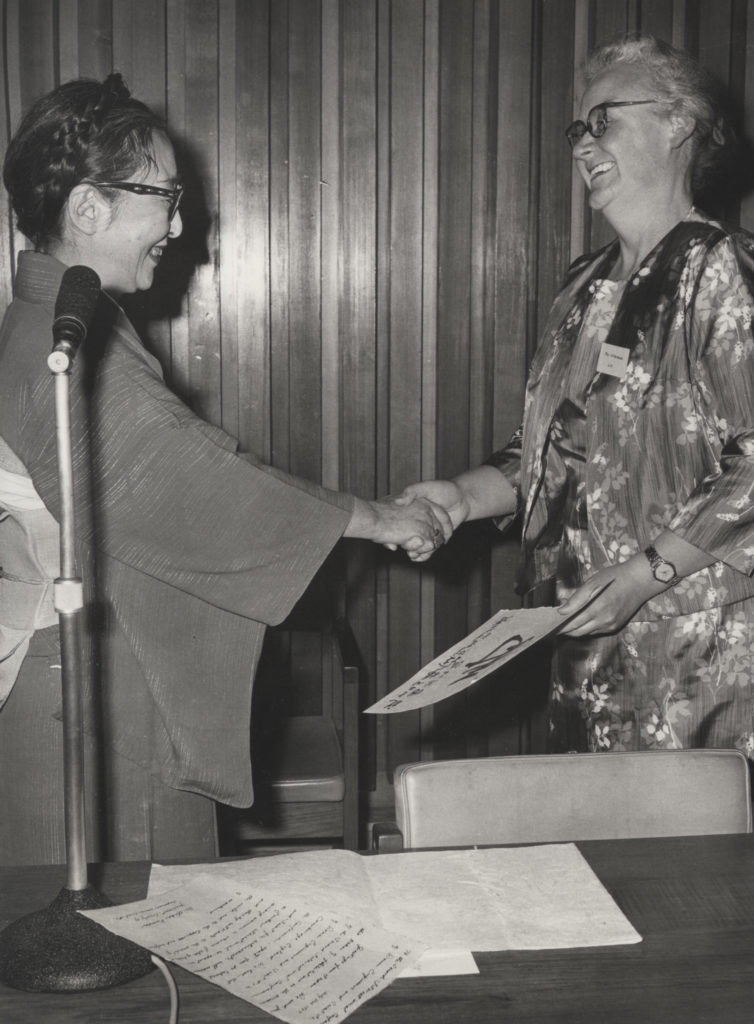
Cancer specialist Dorothy Mizoguchi (pictured above with Isabel Hardwich), who also attended both the first two conferences, has no English language Wikipedia page, and there is also no page about the Society of Japanese Women Scientists, a body that is still active. This is one of the starting points for potential further research that arise from looking at who attended the first two conferences.
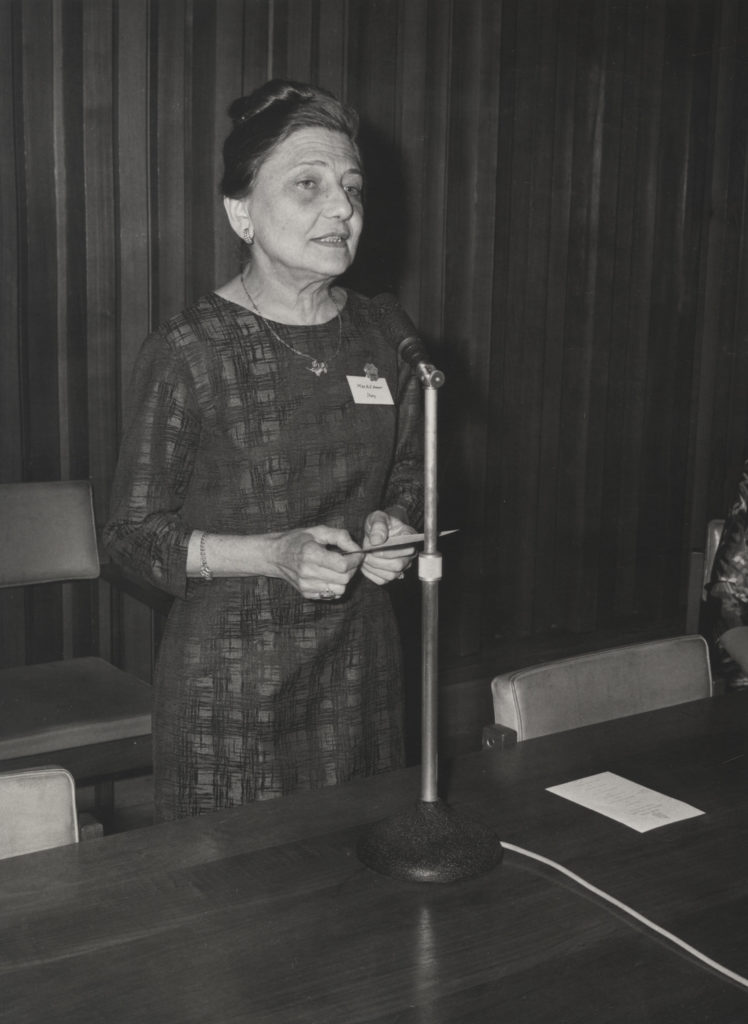
Anna Amour at the second ICWES conference in Cambridge, England, 1967. Image from the IET Archives, NAEST 092 15 02 05. 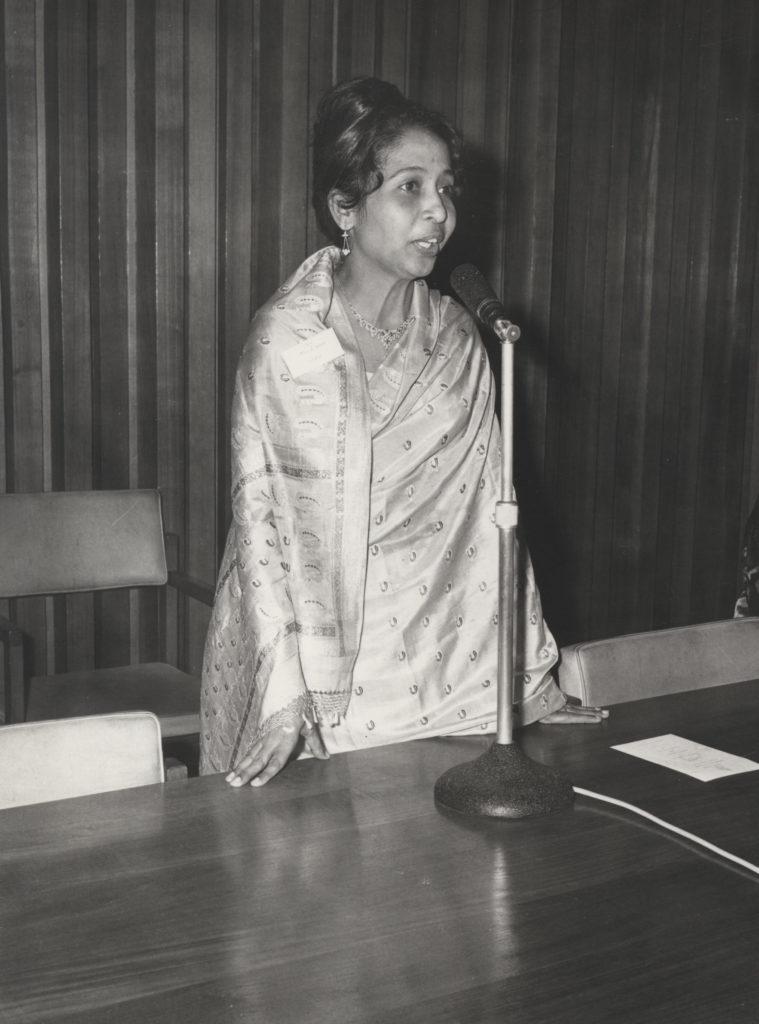
Ila Ghose at the second ICWES conference in Cambridge, England, 1967. Image from the IET Archives, NAEST 092 15 02 05.
Other examples of women who attended both 1964 and 1967 conferences (and likely several subsequent ones too) warrant attention too. We know from WES’s journal The Woman Engineer that Dr Anna Amour (pictured above left) from Italy, for example, was a key organiser of the 1971 ICWES conference in Turin, Italy and active in AIDIA (the Italian Association for Women in Engineering and Architecture). There is only very limited information on her available online such as this short biography in Italian.
Professor Mahin Rahmani (pictured below) from the Nuclear Centre, Tehran University, in Iran, also attended both the first two conferences, but again information on her is not readily available, although she is mentioned as an honorary member of INWES in newsletters as recently as 2015.
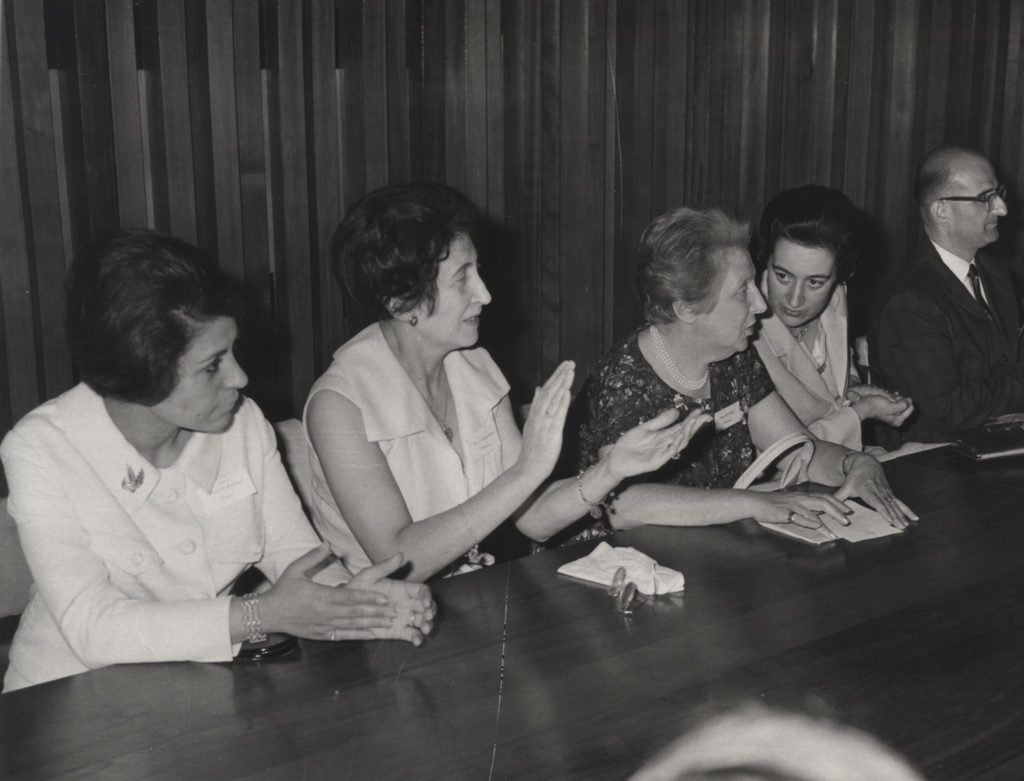
Ila Ghose, who attended the second ICWES conference (pictured above on the right), has an entry on Wikimedia Commons, which includes a wonderful image of her, and a description of her as the first mechanical engineer from India, yet she does not have her own Wikipedia page. There is, however, this newspaper article about her life.
The spreadsheet data on ICWES attendance also tells us much about the different jobs held by women. Employment types range from academic positions to engineering roles at many different levels, from assistants to directors. Only 90 of the 802 records from both conferences lack some description of their work.
For attendees from the UK and the USA, there’s enough data to find out if there were particular companies or universities where these women were clustered. Further research could then be done to find out more about other women who worked there. Evidently for anyone interested in STEM work undertaken by women in the 1960s this data is a rich resource for future research.
Of course, the data supplied by ICWES registration documents does have limitations too. It only provides surface level data about the attendees at a snapshot in time so cannot, of itself, tell the full story. Not every entry is complete – for example, students did not always specify their field of study when registering. Some retired attendees gave no information about their professional specialism. And it is not always clear if the country specified is an attendee’s country of residence or their nationality since many women moved around to study and work.
Additionally, the organisation committees for the first two ICWES conferences were both engineering organisations, which might explain the preponderance of engineers present. Women’s broader contribution to the various scientific arenas may not be fully represented in this data. In a similar vein, the conferences only reached sub-sections of the world’s population; since only a few women would have had the free time and access to resources to support attendance, the data cannot be taken as fully representative of the global picture of women in STEM at the time.
So inevitably, cross referencing the ICWES attendance data with other sources is necessary to grasp more of the story of the first two conferences. Archival material from SWE and WES, as well as other collections held at the IET, including the Isabel Hardwich papers, can provide us with conference documentation, photographs, and correspondence. The photographs included here from the 1967 conference (kindly supplied by the IET archives) have already helped to match names to faces of many of the women highlighted.
Further source material could help to tell us more about how participants were contacted, what the conferences entailed, and how they were reported. A previous Electrifying Women blogpost has already started to explore how The Woman Engineer can help tell us more about the international participants at the 1967 ICWES meeting.
There are also the later 15 conferences to discover more about using the archives of the committees that organised each of these. Turin, Italy (1971); Cracow, Poland (1975); Rouen, France (1975); Bombay, India, (1981); Washington DC, USA (1984); Abidjan, Ivory Coast (1988); Warwick, UK (1991); Budapest, Hungary (1996); Chiba, Japan (1999); Ottawa, Canada (2002); Seoul, Korea (2005); Lille, France (2008); Adelaide, Australia (2011); Los Angeles, USA (2014); New Delhi, India (2017) – and ICWES 18 postponed to 2021 will take place in Coventry, UK
And then it would be necessary to look beyond the ICWES conferences to locate as yet unknown histories of women working in STEM fields across the world. There’s much research still to be done!
To aid this research, the spreadsheet we have compiled containing the full list of registered attendees for the 1964 and 1967 ICWES conferences is available to download from the International page. We welcome you to download a copy to see what you might find.